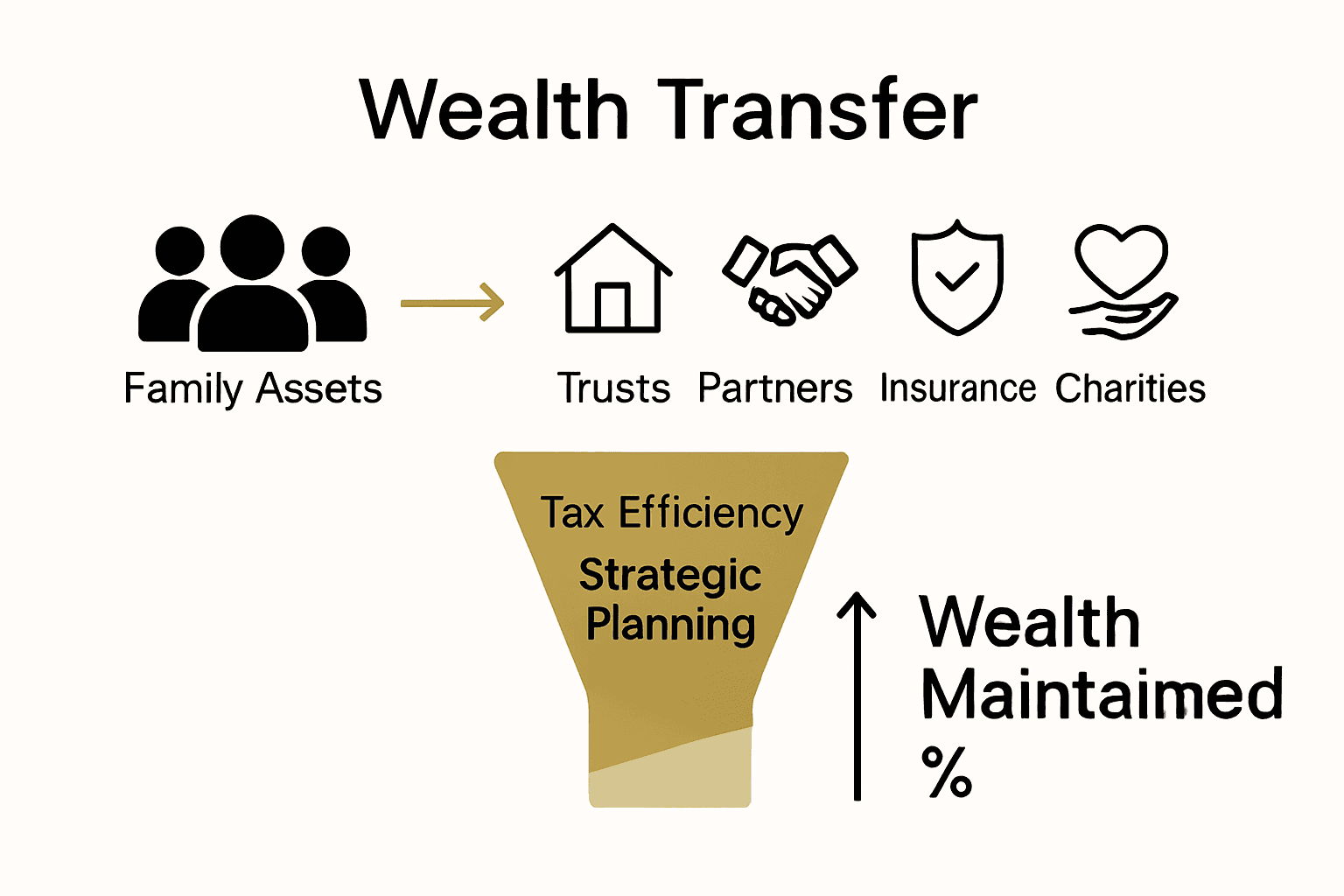Over 90 percent of family wealth is lost by the third generation, according to recent studies. This eye-opening fact highlights why understanding generational wealth planning is more important than ever for families who want to secure a lasting legacy. By looking beyond short-term financial goals and building a framework that includes education, governance, and values, families can set the stage for long-term stability and growth.
Table of Contents
- Defining Generational Wealth Planning Fundamentals
- Types Of Generational Wealth Strategies Explained
- Key Structures And Vehicles For Wealth Transfer
- Legal And Tax Considerations For Families
- Risks, Challenges, And Common Mistakes To Avoid
Key Takeaways
| Point | Details |
|---|---|
| Holistic Approach | Generational wealth planning should encompass financial strategy, family governance, and shared values to ensure sustainable legacy growth. |
| Education and Communication | Promoting financial literacy among family members is crucial for responsible wealth management and cohesive family dynamics. |
| Strategic Structures | Utilizing legal and financial instruments like trusts and partnerships is essential for efficient wealth transfer and tax minimization. |
| Proactive Management | Regular reviews and adaptive strategies are vital to navigating changing economic landscapes and preserving family wealth across generations. |
Defining Generational Wealth Planning Fundamentals
Generational wealth planning represents a strategic approach to preserving and expanding financial resources across multiple family generations. According to iilife, this process transcends simple financial management, encompassing leadership, education, and shared family values. Generational wealth planning is fundamentally about creating a sustainable financial legacy that extends beyond immediate monetary concerns.
The core philosophy of generational wealth planning involves several critical dimensions. As iilife highlights, high-net-worth families strategically build enduring legacies through:
- Financial Literacy: Educating family members about sophisticated wealth management techniques
- Estate Planning: Structuring legal and financial frameworks for seamless asset transfer
- Long-Term Investments: Developing investment strategies with multi-generational perspectives
- Family Governance: Establishing clear protocols for financial decision making
- Philanthropic Engagement: Creating meaningful social impact while preserving family wealth
Successful generational wealth planning requires a holistic approach that balances financial strategy with family dynamics. It demands not just intelligent investment choices, but also cultivating a shared understanding of financial responsibility among family members. Explore our guide on wealth transfer planning to dive deeper into the nuanced strategies that can help families maintain and grow their financial legacies across generations.
Types of Generational Wealth Strategies Explained
Generational wealth strategies represent sophisticated financial approaches designed to preserve and grow family assets across multiple generations. According to Nasdaq, these strategies encompass multiple sophisticated techniques that go far beyond traditional investment methods. Wealth transfer strategies are complex, nuanced approaches that require careful planning and strategic implementation.
Key generational wealth strategies include:
- Family Limited Partnerships (FLPs): Legal structures for efficient asset management and controlled wealth transfer
- Charitable Giving Plans: Strategic philanthropic approaches that generate significant tax benefits
- Life Insurance Policy Utilization: Creating liquidity and financial protection for future generations
- Retirement Account Beneficiary Designations: Streamlining asset transfer mechanisms
As iilife highlights, high-net-worth families also employ comprehensive strategies like establishing family governance structures, creating dedicated family offices, and conducting periodic strategy reviews. These approaches ensure that wealth management remains adaptive and responsive to changing economic landscapes. Explore our guide on wealth structuring to gain deeper insights into how sophisticated families protect and grow their financial legacies across generations.
Key Structures and Vehicles for Wealth Transfer
Wealth transfer strategies rely on sophisticated legal and financial structures designed to preserve and efficiently distribute family assets across generations. According to Nasdaq, several key vehicles emerge as critical tools for sophisticated wealth management. Wealth transfer vehicles provide strategic mechanisms to minimize tax implications while ensuring smooth asset transition.

Key structures for generational wealth transfer include:
Here’s a summary of key wealth transfer structures and their core benefits:
| Structure | Main Purpose | Key Benefit |
|---|---|---|
| Family Limited Partnerships | Centralized asset control | Controlled ownership transfer |
| Charitable Remainder Trusts | Philanthropic giving | Tax-efficient distributions |
| Dynasty Trusts | Long-term preservation | Minimize transfer taxes |
| Life Insurance Policies | Liquidity & equalization | Smooth asset distribution |
- Family Limited Partnerships (FLPs): Centralized asset management with controlled ownership transfer
- Charitable Remainder Trusts (CRTs): Tax-efficient philanthropic giving strategies
- Dynasty Trusts: Long-term wealth preservation mechanism
- Life Insurance Policies: Liquidity generation and equitable wealth distribution
Wikipedia highlights that dynasty trusts represent particularly powerful wealth transfer vehicles, enabling assets to grow and compound over extended periods while minimizing federal transfer taxes like estate, gift, and generation-skipping taxes. These irrevocable trusts provide a sophisticated mechanism for families to protect and grow wealth across multiple generations.
 Explore our guide on private wealth structuring to understand how these intricate strategies can be tailored to your family’s unique financial landscape.
Explore our guide on private wealth structuring to understand how these intricate strategies can be tailored to your family’s unique financial landscape.
Legal and Tax Considerations for Families
Generational wealth planning demands sophisticated legal and tax strategies to preserve family assets while minimizing financial liabilities. According to Nasdaq, families must carefully navigate complex legal frameworks to effectively manage wealth transfer. Tax optimization becomes a critical component of comprehensive wealth preservation strategies.
Key legal and tax considerations include:
- Estate Tax Minimization: Structuring assets to reduce potential tax burdens
- Charitable Giving Strategies: Leveraging tax deductions through philanthropic planning
- Asset Protection Mechanisms: Creating legal structures that shield family wealth
- Inheritance Tax Planning: Developing strategies to minimize tax implications for heirs
Wikipedia highlights that dynasty trusts represent a sophisticated approach to tax management, enabling families to remove assets from their taxable estate and avoid estate taxes during generational transfers. These intricate legal vehicles address generation-skipping transfer (GST) tax implications while providing a robust framework for long-term wealth preservation. Discover our essential tax planning tips to gain deeper insights into navigating the complex landscape of family wealth management and tax optimization.
Risks, Challenges, and Common Mistakes to Avoid
Generational wealth planning is fraught with complex challenges that can potentially erode carefully accumulated family assets. According to iilife, one of the most significant risks is the potential loss of wealth by the second or third generation due to poor financial stewardship. Wealth preservation requires ongoing strategic management and proactive family engagement.
Key risks and common mistakes in generational wealth planning include:
- Lack of Financial Education: Failing to prepare younger generations for responsible wealth management
- Inadequate Governance Structures: Not establishing clear family financial decision-making protocols
- Poor Communication: Neglecting transparent discussions about wealth, values, and financial responsibilities
- Static Strategy Approach: Failing to conduct periodic reviews and adapt strategies to changing economic landscapes
The most critical challenge lies in maintaining family cohesion and financial literacy across generations. Families must recognize that wealth transfer is more than a financial transaction—it’s a comprehensive process of knowledge transfer, values alignment, and strategic planning.
Explore our essential family office risk management tips to develop a robust approach that protects and grows your family’s financial legacy through thoughtful, adaptive strategies.
Secure Your Family’s Financial Legacy with Expert Generational Wealth Solutions
Navigating the complex world of generational wealth planning can feel overwhelming. The challenges of estate tax minimization and ensuring smooth wealth transfer demand more than just financial knowledge — they require a trusted community and proven strategies. High-net-worth families know that without clear governance, ongoing education, and adaptive planning, sustaining wealth across generations becomes a steep uphill battle.

Take control of your family’s future now by connecting with experts and resources designed specifically for ultra-high-net-worth investors. At Future Family Office, you gain access to a global platform that demystifies private wealth management and supports you with:
- A comprehensive network of family offices and service providers
- Industry news focused on generational wealth strategies and tax optimization
- Tools to help build governance, asset protection, and long-term investment plans
Don’t let your hard-earned wealth diminish through missed opportunities or avoidable mistakes. Visit Future Family Office, explore our wealth transfer planning guide, and discover how to structure your family governance for lasting success today.
Frequently Asked Questions
What is generational wealth planning?
Generational wealth planning is a strategic approach focused on preserving and expanding financial resources across multiple family generations, incorporating aspects like financial literacy, estate planning, and family governance.
Why is financial literacy important in generational wealth planning?
Financial literacy is crucial in generational wealth planning as it equips family members with the necessary skills and knowledge to manage wealth responsibly and make informed financial decisions.
What are some common wealth transfer strategies?
Common wealth transfer strategies include Family Limited Partnerships (FLPs), charitable giving plans, life insurance policies, and utilizing retirement account beneficiary designations to ensure effective asset transfer.
What are the risks associated with generational wealth planning?
Key risks include lack of financial education for younger generations, inadequate governance structures, poor communication about financial responsibilities, and static strategy approaches that fail to adapt to changing circumstances.
Recommended
- The Essential Guide to Wealth Transfer Planning – Future Family Office
- Understanding the Role of Estate Planning for Wealth Management – Future Family Office
- Optimize Your Wealth Transfer Planning Workflow Effectively – Future Family Office
- What is Philanthropic Planning? A Deep Dive into Its Importance – Future Family Office




